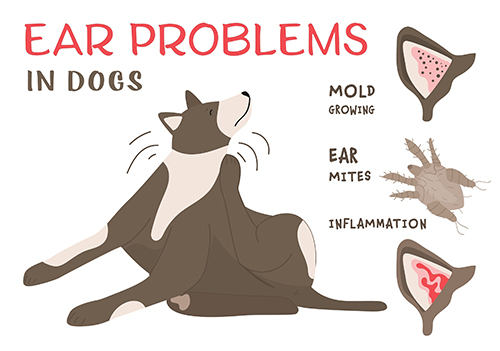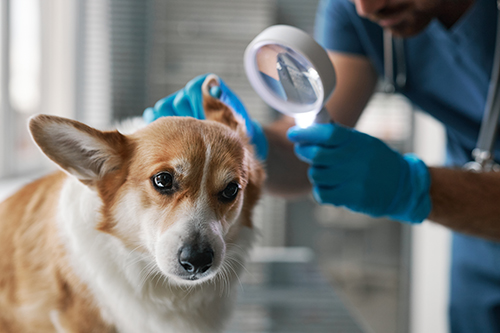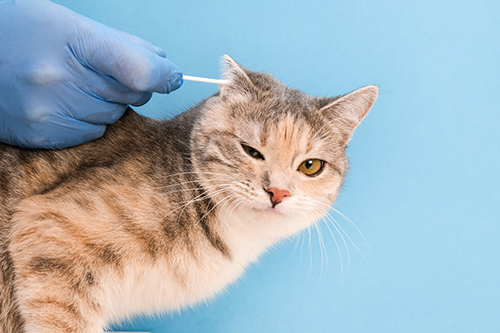Pet Ear Infection
Pet Ear Infection
Introduction:
pets are important partners in our life, they bring us endless joy and companionship. However, with the increase of pets, we also face some health problems related to it, among which ear infection is one of the more common. Pet ear infections not only affect your pet's quality of life, but can also cause serious health problems. Therefore, understanding the causes, symptoms, diagnosis and treatment of pet ear infections is essential to maintain pet health.

pet ear infection symptoms:
frequent ear scratching is one of the most common manifestations of pet ear infections, which can cause itching and discomfort inside the ear canal. Ear odor is also another common symptom, which is usually caused by bacteria and fungi that break down the secretions inside the ear canal due to infection. In addition, redness or swelling of the ears is a typical manifestation of pet ear infections, which may be due to an inflammatory reaction caused by the infection. Increased ear discharge is also one of the common symptoms of pet ear infections, usually manifested as an increase in earwax or pus. Dizziness or balance problems can be serious symptoms of a pet's ear infection, which may be caused by an inner ear problem caused by the infection and requires prompt medical attention.
pet ear infection
during the physical examination, the veterinarian will check the appearance of the pet's ears to see if there are symptoms such as redness and swelling and increased secretions. Abnormal appearance is often related to infection. Visual examination is an important way to further confirm an ear infection, and veterinarians may use an otoscope to examine the inside of the ear canal to see if there are foreign bodies, redness, ulcers, and other lesions.
Ear swabs are done by taking secretions from the inside of the ear canal for bacterial culture or fungal testing to confirm the type and severity of the infection. Ear swab examination has high accuracy and reliability for the diagnosis of pet ear infection, and is one of the commonly used diagnostic methods in clinical practice.

pet ear infections
treatment of pet ear infections usually includes medication, cleaning and care, and parasite prevention. Drug therapy is one of the main methods for the treatment of pet ear infections, including the use of antibiotics, antifungal drugs and antiviral drugs. Drug therapy can effectively remove the pathogens of ear infections, relieve symptoms and promote healing. Cleaning and care is an important complement to the treatment of pet ear infections, including the use of mild detergents to clean the ear canal, regular ear cleaning andAvoid excessive cleaningand so on.
a healthy ear canal: Clean it once a week or every half a month. Excessive cleaning can hurt your cat's ears. Ear disease of the ear canal: if suffering from ear mites, fungi, bacterial infection, need a week to clean up3-5 times. In severe cases, it is necessary to clean and apply medicine every day. The number of times the sick cat's ear is cleaned needs to be followed by the doctor. Proper cleaning and care can help restore the natural balance of the ear canal and reduce the risk of infection.
parasite prevention is another important aspect in the treatment of pet ear infections, especially for ear mite infections, regular deworming can effectively prevent the occurrence and recurrence of infection. Here are some common anthelmintic drugs:
external anthelmintic drugs:
- Fipronil (Fipronil): Used externally to repel fleas, ticks and fleas.
- imidacloprid (Imidacloprid): Used externally to repel fleas, fleas and some ticks.
- ivermectin (Selamectin): Used externally to repel fleas, fleas, roundworms and ear mites.
- cantharimide (Spinosad): Used externally to repel fleas.
internal anthelmintic drugs:
- praziquantel (Pyrantel): Used to repel intestinal parasites such as roundworms, hookworms and backworms.
- bromochlorobactin (Milbemycin): Used to repel intestinal parasites such as heartworm, roundworm, hookworm, caterpillar and spiral worm.
- milk thiamine (Praziquantel): Used to repel trematodes and tapeworms, etc.
In general, the frequency of insect repellent for pets is: external drive: once every 1 month; Internal drive: once every 2-3 months. The frequency of deworming can also be carried out with reference to the drug instructions or the advice of a pet doctor.

pet ear infection prevention measures:
the key to prevent pet ear infection is to take a series of effective measures. Pet owners should regularly check the appearance of their pet's ears to see if there are any abnormalities such as redness and swelling, increased secretions, etc. Maintaining dryness and ventilation is the key to preventing pet ear infections, especially in a humid environment. Keeping the pet's living environment dry and ventilated can reduce the growth of bacteria and fungi. Pay attention to cleaning is an important aspect of preventing pet ear infections. Clean your pet's ears regularly, but avoid over-cleaning so as not to destroy the natural balance inside the ear canal. In addition, pay attention to diet and nutrition is also the key to prevent pet ear infection. Reasonable diet and nutrition can enhance the function of pet's immune system and reduce the risk of infection. Paying close attention to the behavior and health status of pets is also one of the important means to prevent pet ear infection. If abnormal conditions are found, timely medical treatment can effectively prevent the occurrence and recurrence of infection and ensure the health and happy life of pets.
